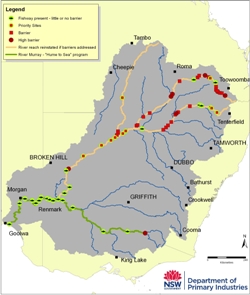
Fishway options for weirs in the northern Murray-Darling Basin

Murray-Darling Basin showing location of priority structures for improving fish passage in the northern Basin and sites where fish passage has been reinstated (such as through the Hume to the Sea project on the mainstem Murray River).
Barriers to migration have been identified as a major contributor to the decline of native fish species within the Murray Darling Basin. Recognition within the Murray-Darling Basin Authority’s (MDBA) Native Fish Strategy of their impacts on river health and their listing as a key threatening process in state and Commonwealth threatened species legislation is evidence of their impact on aquatic biodiversity.
The MDBA have made significant investment in improving fish passage along the Murray River and associated anabranches through the Lake Hume to the Sea program and the Living Murray Initiative, although this investment has not been matched in the Northern Murray-Darling Basin. At present, the movement of fish within and between river systems north of Menindee Lakes remains significantly restricted by dams and weirs without adequate fish passage.
In late 2009, the NSW Department of Primary Industries and the (now) Department of Qld Department of Agriculture, Fisheries and Forestry were commissioned by the MDBA to develop concept designs and engineering costings for ten of the highest priority weirs in the Northern Murray-Darling Basin.
This project developed both concept designs and costings for remediation of priority weirs using the five surrogate structures which were viewed as representative of the remaining priority sites. Fishway concepts were specifically designed to suit the fish assemblage and semi-arid ecology of the northern Basin and considered constructability, materials, regional context, maintenance and ownership.
The project identified that there are two feasible approaches to rehabilitating fish passage in the northern Basin in rivers that span both NSW and Queensland.
Strategy 1:Provide fish passage at the top 11 priority structures to reinstate 2,086 km of river channel
Cost estimated to be between $18.51 million and $28.26 million.
The program would address priority barriers in the Darling, Dumaresq, Condamine and Warrego rivers and greatly improve conditions for native fish by targeting sites adjacent to existing fishways to get multiple benefits, or by reconnecting long reaches of high quality habitat.
Strategy 2: Provide a strategic, holistic, program re-establishing broad-scale river connectivity of over 3,242 km
Cost is estimated to be from $72.74 million to $95.86 million.
In this program all weirs (42 mainstem structures) would be remediated on the Darling River and its three key tributaries, with the program also including eight high level structures where fish locks or fish lifts would be required.Like the ‘Hume to the Sea’ program this approach is aimed at ecosystem rehabilitation. In this case it is an arid river ecosystem and it has not previously received significant investment in rehabilitation. The reinstatement of fish passage in the mainstem Darling and major tributaries would provide immense benefit to fish communities throughout the catchment and make a major contribution to ecosystem restoration.
| Download | ||
|---|---|---|
| Fishway-Options-for-Weirs-of-the-Northern-MDB-no-app-121212-for-web.pdf |
750.7 KB | |
| SMEC-Fish-Passage-Engineering-Report-Final-010311_opt.pdf |
2.6 MB | |

